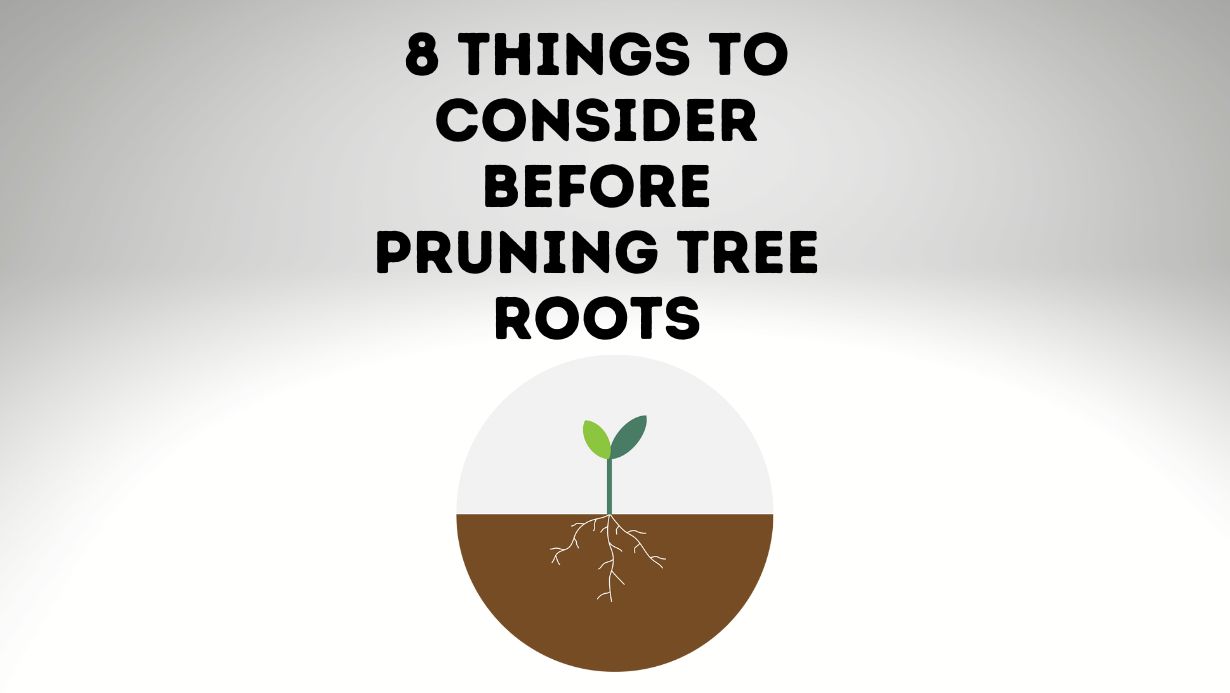
Tree roots are vital for the overall health and stability of a tree. But, sometimes, we need to prune roots. It’s possible to prune roots. However, there is a lot we must first consider.
Two significant consequences of incorrect root pruning are:
- The death of a tree
- The toppling over of a tree
I’ll teach you what to consider before root pruning in this guide. With this knowledge, you will be able to think twice before pruning. You will also recognize when an expert’s opinion is needed.

What to Consider Before Pruning Tree Roots
Here’s what you need to think about before pruning the roots of a tree. Below, I will expand on each point.
- Age of Tree
- Number of Roots That Need Pruning
- Overall Health of the Tree
- The Species of Tree
- Structural Root Zone
- Soil Type
- Lean of Tree
- Biosecurity

Age of Tree
The tree’s age will affect how the tree responds to root pruning. A young tree will respond to root pruning much better than a mature tree.
Young trees have a much smaller root diameter. A small root diameter means you aren’t making significant cuts. So, the tree doesn’t have to work as hard to remediate any cuts.
Pruning large roots in mature trees can also affect the tree’s stability. Pruning the wrong root may result in the tree toppling over during the next storm.
Number of Roots That Need Pruning
Look to prune the least amount of roots as possible. Pruning too many roots can alter how much water and nutrients a tree receives.
Again, pruning too many roots may affect the stability of the tree.
Overall Health of the Tree
Healthy trees will respond to root pruning much better than stressed or sick trees. So, before pruning a tree root, perform a health assessment of the tree.
A healthy tree can divert nutrients and resources wherever it needs them.
A sick/stressed tree may not have the extra resources to begin the healing process. Thus, pruning the roots of an unhealthy tree may accelerate its decline. Pruning roots could even kill the tree.
The Species of Tree
The species of the tree may affect how that tree responds to pruning. Some species will tolerate heavy root pruning without any problems. In contrast, another species might suffer from only minimal root pruning.
Also, different species have different root architectures. The various root architectures stabilize a tree in different ways. For example:
Trees with a sinker root system may tolerate the pruning of roots close to the trunk. A sinker root system consists of a broad plate of lateral roots. These lateral roots then develop vertical roots that grow deep underground. This root system creates a root cage that holds a lot of soil.
The heavy root cage holds the tree in place. It would take a lot of force to move a tree with a sinker root system. So, these trees have been known to tolerate the pruning of roots near the trunk.
In other trees, roots near the trunk contribute significantly to the tree’s stability. So, pruning these roots can be disastrous to trees without a sinker root system.
Most young trees begin with a sinker root system, which adds to their resistance to root pruning.
Structural Root Zone
The structural root zone (SRZ) is a section of roots that contributes to the stability of a tree. As a general guide, the SRZ is usually close to the tree’s base.
The further away from the tree’s base, you prune roots, the less of an effect pruning will have on the tree’s stability. As a rule of thumb, prune roots at a minimum of five times the trunk’s diameter away from the tree.
Pruning within the SRZ should only be done with advice from an expert.
For more information about tree roots in general, including how to work out a tree’s SRZ, check out this article.
Soil Type
In most trees, you will find almost 99% of the roots in the top one meter of soil. Water, oxygen, and nutrients are more accessible in this layer of soil.
However, specific soil and site types can influence the root structure. For example:
Shallow soil has little room for water storage and root movement. So, in shallow soils, you find most roots near the soil’s surface. Pruning these roots may affect the tree’s stability.
Lean of Tree
It’s not uncommon for trees to develop a lean. It’s not necessarily bad either, as tree roots will adapt to support the tree. However, pruning these support roots can cause the tree to fall.
For example:
The guy-rope root is one of the essential roots on a leaning tree. Severing this root can severely affect the tree’s stability.
The guy-rope root is a long, thick root located on the upper side of the tree. The leaning tree puts tension on this root. However, the root is strong enough to support the tree.
Say you had a rope pegged to the ground. You could hole the rope and lean back, away from the peg. The rope would support you. But, you couldn’t lean forwards into the rope in the direction of the peg. You’d fall over as the rope couldn’t support you in that direction.
A guy-rope root works the same way.
Biosecurity
Whenever you prune a tree, you open the tree up to infection. Whether you’re pruning a limb or pruning roots, you need to limit exposure to pathogens and disease.
Think of pruning a tree as performing surgery on a human.
A surgeon will operate in a clean, sterile room. All the surgeon’s tools and equipment will be sterilized. All this cleanliness minimizes the risk of infection.
Working with trees should be the same. Ensure you sterilize all tools and equipment. Once you finish pruning, cover the root with the same soil.
After, monitor the tree for signs of disease or infection.
